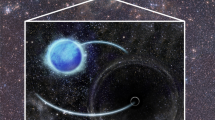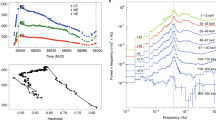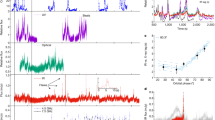Abstract
Most ultraluminous X-ray sources1 have a typical set of properties not seen in Galactic stellar-mass black holes. They have luminosities of more than 3 × 1039 ergs per second, unusually soft X-ray components (with a typical temperature of less than about 0.3 kiloelectronvolts) and a characteristic downturn2,3 in their spectra above about 5 kiloelectronvolts. Such puzzling properties have been interpreted either as evidence of intermediate-mass black holes4,5 or as emission from stellar-mass black holes accreting above their Eddington limit6,7, analogous to some Galactic black holes at peak luminosity8,9. Recently, a very soft X-ray spectrum was observed in a rare and transient stellar-mass black hole10. Here we report that the X-ray source P13 in the galaxy NGC 779311 is in a binary system with a period of about 64 days and exhibits all three canonical properties of ultraluminous sources. By modelling the strong optical and ultraviolet modulations arising from X-ray heating of the B9Ia donor star, we constrain the black hole mass to be less than 15 solar masses. Our results demonstrate that in P13, soft thermal emission and spectral curvature are indeed signatures of supercritical accretion. By analogy, ultraluminous X-ray sources with similar X-ray spectra and luminosities of up to a few times 1040 ergs per second can be explained by supercritical accretion onto massive stellar-mass black holes.
This is a preview of subscription content, access via your institution
Access options
Subscribe to this journal
Receive 51 print issues and online access
$199.00 per year
only $3.90 per issue
Buy this article
- Purchase on Springer Link
- Instant access to full article PDF
Prices may be subject to local taxes which are calculated during checkout



Similar content being viewed by others
References
Feng, H. & Soria, R. Ultraluminous X-ray sources in the Chandra and XMM-Newton era. New Astron. Rev. 55, 166–183 (2011)
Gladstone, J. C., Roberts, T. P. & Done, C. The ultraluminous state. Mon. Not. R. Astron. Soc. 397, 1836–1851 (2009)
Roberts, T. P., Warwick, R. S., Ward, M. J., Goad, M. R. & Jenkins, L. P. XMM-Newton/EPIC observations of the ultraluminous X-ray source NGC 5204 X-1. Mon. Not. R. Astron. Soc. 357, 1363–1369 (2005)
Colbert, E. J. M. & Mushotzky, R. F. The nature of accreting black holes in nearby galaxy nuclei. Astrophys. J. 519, 89–107 (1999)
Miller, J. M., Fabbiano, G., Miller, M. C. & Fabian, A. C. X-ray spectroscopic evidence for intermediate-mass black holes: cool accretion disks in two ultraluminous X-ray sources. Astrophys. J. 585, L37–L40 (2003)
Poutanen, J., Lipunova, G., Fabrika, S., Butkevich, A. G. & Abolmasov, P. Supercritically accreting stellar mass black holes as ultraluminous X-ray sources. Mon. Not. R. Astron. Soc. 377, 1187–1194 (2007)
Kawashima, T. et al. Comptonized photon spectra of supercritical black hole accretion flows with application to ultraluminous X-ray sources. Astrophys. J. 752, 18–29 (2012)
Done, C., Wardziński, G. & Gierliński, M. GRS 1915+105: the brightest Galactic black hole. Mon. Not. R. Astron. Soc. 349, 393–403 (2004)
Middleton, M. J. et al. Bright radio emission from an ultraluminous stellar-mass microquasar in M 31. Nature 493, 187–190 (2013)
Liu, J., Bregman, J. N., Bai, Y., Justham, S. & Crowther, P. Puzzling accretion onto a black hole in the ultraluminous X-ray source M 101 ULX-1. Nature 503, 500–503 (2013)
Motch, C., Pakull, M. W., Grisé, F. & Soria, R. The supergiant optical counterpart of ULX P13 in NGC 7793. Astron. Nachr. 332, 367–370 (2011)
Read, A. M. & Pietsch, W. ROSAT observations of the Sculptor galaxy NGC 7793. Astron. Astrophys. 341, 8–22 (1999)
Pannuti, T. G. et al. A Chandra observation of the nearby Sculptor group Sd galaxy NGC 7793. Astron. J. 142, 20–38 (2011)
Radburn-Smith, D. J. et al. The GHOSTS survey. I. Hubble Space Telescope Advanced Camera for Surveys data. Astrophys. J. Suppl. Ser. 195, 18–45 (2011)
Schlegel, D. J., Finkbeiner, D. P. & Davis, M. Maps of dust infrared emission for use in estimation of reddening and cosmic microwave background radiation foregrounds. Astrophys. J. 500, 525–553 (1998)
Pietrzyński, G. et al. The Araucaria Project: first Cepheid distance to the Sculptor group galaxy NGC 7793 from variables discovered in a wide-field imaging survey. Astron. J. 140, 1475 (2010)
Meynet, G. & Maeder, A. Stellar evolution with rotation. V. Changes in all the outputs of massive star models. Astron. Astrophys. 361, 101–120 (2000)
Giacconi, R. et al. Further X-ray observations of Hercules X-1 from Uhuru. Astrophys. J. 184, 227–236 (1973)
Deeter, J. et al. Analysis of periodic optical variability in the compact X-ray source HER X-1/HZ Herculis. Astrophys. J. 206, 861–868 (1976)
Orosz, J. A. & Hauschildt, P. H. The use of the NextGen model atmospheres for cool giants in a light curve synthesis code. Astron. Astrophys. 364, 265–281 (2000)
Kudritzki, R. P. et al. The wind momentum-luminosity relationship of galactic A- and B-supergiants. Astron. Astrophys. 350, 970–984 (1999)
Podsiadlowski, P., Rappaport, S. & Han, Z. On the formation and evolution of black hole binaries. Mon. Not. R. Astron. Soc. 341, 385–404 (2003)
Rappaport, S. A., Podsiadlowski, P. & Pfahl, E. Stellar-mass black hole binaries as ultraluminous X-ray sources. Mon. Not. R. Astron. Soc. 356, 401–414 (2005)
Patruno, A. & Zampieri, L. The black hole in NGC 1313 X-2: constraints on the mass from optical observations. Mon. Not. R. Astron. Soc. 403, L69–L73 (2010)
Lennon, D. J., Dufton, P. L. & Fitzsimmons, A. Galactic B-supergiants. I - an atlas of O9–B9 supergiant spectra from 3950 A to 4950 A. Astron. Astrophys. 94 (suppl.). 569–586 (1992)
Markova, N. & Puls, J. Bright OB stars in the Galaxy. IV. Stellar and wind parameters of early to late B supergiants. Astron. Astrophys. 478, 823–842 (2008)
Zorec, J. et al. Fundamental parameters of B supergiants from the BCD system. I. Calibration of the (λ1, D) parameters into Teff . Astron. Astrophys. 501, 297–320 (2009)
Still, M. D., Quaintrell, H., Roche, P. D. & Reynolds, A. P. Spectral signatures of reprocessing on the companion and accretion disc of Hercules X-1. Mon. Not. R. Astron. Soc. 292, 52–62 (1997)
Pearson, K. J. et al. Multiwavelength observations of EXO 0748–676. II. Emission-line behavior. Astrophys. J. 648, 1169–1180 (2006)
Gierliński, M., Done, C. & Page, K. Reprocessing of X-rays in the outer accretion disc of the black hole binary XTE J1817–330. Mon. Not. R. Astron. Soc. 392, 1106–1114 (2009)
Acknowledgements
R.S. acknowledges an Australian Research Council Discovery Projects funding scheme (project number DP 120102393). F.G. acknowledges support from CNES (CNRS/INSU/CNES contract no. 92532) and partly from the Spanish Ministry of Science and Innovation (MICINN) under grant AYA 2010-18080. Support from the Ideas Plus programme of the Polish Ministry of Science is also acknowledged. We thank J. Orosz for providing us with the ELC code. We acknowledge the Swift team for executing our observing programme. This work is based on observations made with ESO telescopes at the La Silla Paranal Observatory under programme IDs 084.D-0881 and 087.D-0602, and uses observations made with the NASA/ESA Hubble Space Telescope (HST) and obtained from the Hubble Legacy Archive, which is a collaboration between the Space Telescope Science Institute (STScI/NASA), the Space Telescope European Coordinating Facility (ST-ECF/ESA) and the Canadian Astronomy Data Centre (CADC/NRC/CSA). The scientific results reported in this article are based in part on observations made by the Chandra X-ray Observatory and in part on observations obtained with XMM-Newton (OBSIDs 0693760101 and 0693760401), an ESA science mission with instruments and contributions directly funded by ESA member states and NASA.
Author information
Authors and Affiliations
Contributions
C.M. wrote the manuscript with comments from all authors. M.W.P. identified the optical counterpart of P13 and initiated optical observations at the ESO. C.M. and F.G. analysed the spectroscopic and photometric data from several runs at the ESO Very Large Telescope. F.G. analysed the HST data. G.P. provided photometric data from the Warsaw telescope at the Las Campanas Observatory. R.S., F.G. and C.M. designed and analysed the Chandra, XMM-Newton and Swift X-ray observations. C.M. carried out the light-curve fitting using the ELC code. C.M., M.W.P., R.S. and F.G. made significant contributions to the interpretation and discussion of the data. All authors participated in the review of the manuscript.
Corresponding author
Ethics declarations
Competing interests
The authors declare no competing financial interests.
Extended data figures and tables
Extended Data Figure 1 XMM-Newton and Chandra bright-state spectra.
The E × f(E) unfolded energy distribution of the 2003 Chandra/ACIS-S (upper (red) data points) and of the 2013 XMM-Newton/EPIC combined spectra (lower (blue) data points) fitted with the diskir model. Best-fit model parameters are listed in Extended Data Table 1. Spectra shown here have been re-binned with a minimum signal-to-noise ratio of 8 in each bin for display purposes. Error bars show the 1σ statistical error.
Extended Data Figure 2 Optical data.
Optical light and radial velocity curves of P13. a, b, 2004 and 2005 Las Campanas photometry; c, d, ESO VLT light curves; e, f, equivalent width of the He ii λ4,686 emission line; g–j, radial velocity curves of Balmer absorption lines (g, h) and the He ii emission line (i, j). P13 was X-ray bright in 2010 (c, e, g, i) and X-ray faint in 2011 (d, f, h, j). Red arrows in d mark times of the Chandra (near optical maximum) and Swift observations which detected P13 in the faint-X-ray state. Error bars in all panels show statistical uncertainties at the 1σ level. MJD, modified Julian date.
Extended Data Figure 3 The 2010 observations.
a, Red squares, UVOT u band (λeff = 3,470 Å); black lozenges, ESO VLT V light curve. Note the successive maxima separated by ∼64 d, more pronounced in the u band (Δu ≈ 1.0 mag) than in V (ΔV ≈ 0.5 mag). b, Swift/XRT 0.3–10 keV light curve obtained from 2010 August 16 to 2010 October 27. The count-to-flux factor was computed by fitting the XMM-Newton diskir model to the average bright-state spectrum. This implies unabsorbed (0.3–10 keV) X-ray luminosities in the range of 4.8 × 1039 erg s−1 down to less than 1.6 × 1038 erg s−1 on MJD 55492.9 with a weighted average of (2.8 ± 0.2) × 1039 erg s−1. Error bars in all panels show statistical uncertainties at the 1σ level. Errors in V (not shown) are typically lower than 0.04 mag.
Extended Data Figure 4 Power spectra.
a, Lomb–Scargle power spectrum of the entire V light curve. b, Lomb–Scargle power spectrum of the He ii radial velocity curve. The dotted line shows the position of the highest peak of the V-band periodogram (P = 65.165 d).
Extended Data Figure 5 UVOT multiband photometric light curve.
Times of photometric maxima used to constrain the superorbital period in 2012 and 2013 are shown with arrows. Black squares, u (λcentral = 3,465 Å); green lozenges, uw1 (λcentral = 2,600 Å); red lozenges, um2 (λcentral = 2,246 Å); blue lozenges, uw2 (λcentral = 1,928 Å). Error bars show statistical uncertainties at the 1σ level.
Extended Data Figure 6 Orbital and superorbital periods.
Best-fit orbital (Porb = 63.52 d) and superorbital (Ps = 2,620 d ≈ 7.2 yr) solutions accounting for the periodic phase jitter of times of optical/ultraviolet photometric maxima. Error bars show 1σ statistical errors. Five times at which maximum light occurred were extracted from the V-band photometry at MJD 53314.8 ± 3, 53636.4 ± 3, 53699.4 ± 2 (Las Campanas) and MJD 55532.8 ± 3, 55788.0 ± 2 (ESO VLT) and four from the UVOT photometry at MJD 55468.0 ± 2 (u), 56175.0 ± 3 (u), 56243.0 ± 2 (u, um2, uw2), 56303.0 ± 2 (u, um2, uw2).
Extended Data Figure 7 Folded radial velocity curves.
He ii λ4,686 (a) and Balmer absorption (b) radial velocity curves folded with the best-fit combination of orbital and superorbital periods (Porb = 63.52 d and Ps = 2,620 d). Phase 0 corresponds to maximum light. Blue, ESO 2009; black, ESO 2010; red, ESO 2011. The He ii line displays a clear velocity change with orbital phase. Error bars in all panels show statistical uncertainties at the 1σ level.
Extended Data Figure 8 Folded light curves.
u, V and V−I light curves folded with the best-fit combination of orbital and superorbital periods (Porb = 63.52 d and Ps = 2,620 d). Phase 0 corresponds to the predicted time of maximum optical light. Note the different scales used to plot the u and V light curves. a, u: black, 2010 X-ray bright-state run; red, data acquired during the faint-X-ray state in the time interval 2012 September 2 to 2013 January 12. b, V: black, Las Campanas; red, ESO 2010 (X-ray bright); blue, ESO 2011 (X-ray faint). c, Binned V−I light curve. The V−I index is plotted on an arbitrary scale. Error bars in all panels show statistical uncertainties at the 1σ level.
Extended Data Figure 9 High-order Balmer lines.
Normalized mean P13 spectrum away from maximum light (V ≥ 20.3 mag, shifted up by 0.25 for clarity) compared to that of the B8Ia star β Orionis (shifted down by 0.2). The equivalent widths of the high-order Balmer lines H8 and H9 are almost identical in the two stars. The higher interstellar absorption towards P13 than towards Orion is responsible for the stronger Ca ii line in the ULX spectrum. Residual Balmer emission already adds to the photospheric Hδ absorption line and the Hε line is blended with the Ca ii interstellar line. The mean equivalent width of the H8 and H9 Balmer lines are 1.52 ± 0.09 and 1.56 ± 0.08 for β Ori and P13, respectively (1σ errors), consistent with no line veiling in P13.
Supplementary information
Supplementary Information
This fie contains Supplementary Text and Data 1-13 and additional refernces. (PDF 316 kb)
Rights and permissions
About this article
Cite this article
Motch, C., Pakull, M., Soria, R. et al. A mass of less than 15 solar masses for the black hole in an ultraluminous X-ray source. Nature 514, 198–201 (2014). https://doi.org/10.1038/nature13730
Received:
Accepted:
Published:
Issue Date:
DOI: https://doi.org/10.1038/nature13730
This article is cited by
-
Spectral study of X-ray sources in some galaxies recently observed by Chandra
Indian Journal of Physics (2024)
-
On the physical nature of the source of ultraluminous X-ray pulsations
Astrophysics and Space Science (2016)
-
Supercritical accretion disks in ultraluminous X-ray sources and SS 433
Nature Physics (2015)
-
Small field with a large impact
Nature (2014)
Comments
By submitting a comment you agree to abide by our Terms and Community Guidelines. If you find something abusive or that does not comply with our terms or guidelines please flag it as inappropriate.



